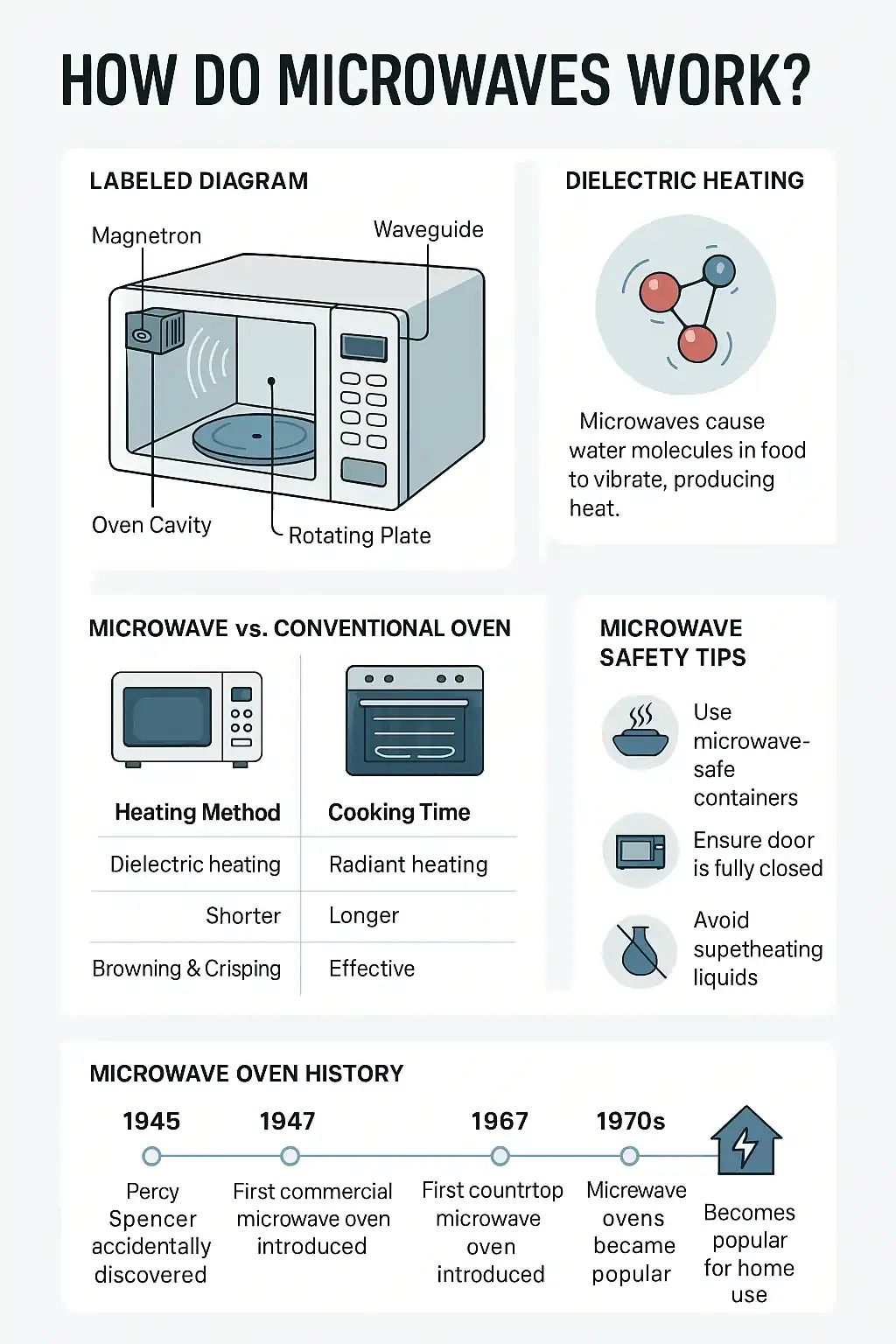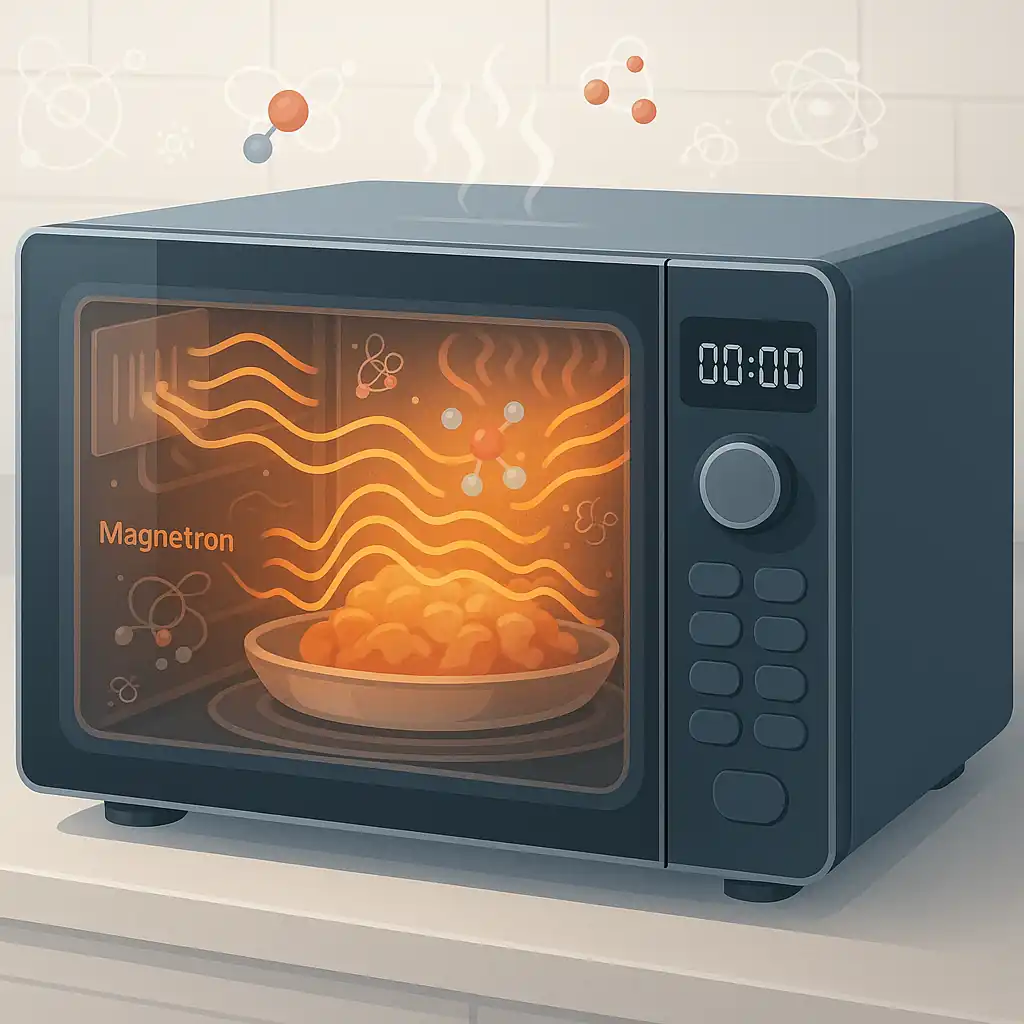How Do Microwaves Work: The Science Behind Microwave Ovens
Microwave ovens are one of the most revolutionary kitchen appliances of the modern age. Found in nearly every household, they heat food rapidly, efficiently, and often with the press of a single button. But despite their convenience, few people understand exactly how microwave ovens work or what happens inside that small box on your countertop.
In this guide, we’ll explore the science, mechanics, safety, and applications of microwave ovens. From the behavior of water molecules to the role of a magnetron, we’ll explain how microwaves cook food through microwave heating and electromagnetic energy.
What Is a Microwave Oven?
A microwave oven is a type of oven that heats food using microwaves—a form of electromagnetic radiation. Unlike a conventional oven that heats food by conduction or convection, a microwave uses high-frequency radio waves to directly excite molecules in food, particularly water molecules, causing them to vibrate and produce heat.
Microwave ovens are often compact, energy-efficient, and widely used in homes, offices, and restaurants for their ability to heat food and cook meals in a fraction of the time needed by traditional cooking appliances.
How Do Microwaves Work? The Science Explained
At the heart of a microwave oven lies a device called a magnetron. This is the component responsible for generating microwave radiation—short radio waves that operate at a frequency of approximately 2.45 gigahertz (GHz). These electromagnetic waves penetrate food and cause polar molecules, especially water molecules, to rapidly vibrate. This vibration generates thermal energy, which in turn heats the food.
The Magnetron: Microwave Generation
A magnetron is a type of vacuum tube that converts electrical energy into microwave energy. When the microwave is turned on, electricity flows into the magnetron, where it accelerates electrons in a circular path. These electrons interact with a magnetic field and create microwaves, which are then directed into the cooking chamber via a waveguide.
Without the magnetron, a microwave oven would not be able to generate the microwave frequencies needed to excite molecules in food.
Dielectric Heating: How Microwave Heating Works
The process of heating food in a microwave is known as dielectric heating. This occurs when the alternating electromagnetic field produced by the microwave oven causes polar molecules, like water, fat, and sugar, to continually rotate.
This rapid oscillation results in rotational energy, which is transformed into thermal energy, effectively heating the food from the inside out—though not as deeply as many people assume.
Water Molecules and Microwave Heating
The most important target for microwave heating is the water molecule. Water is a dipolar molecule, meaning it has a positive and a negative end. The electromagnetic field of the microwave causes these water molecules in the food to spin rapidly, generating heat through friction.
This is why foods with higher water content, like soup or vegetables, heat up much faster in a microwave oven than drier items like bread or crackers.
The Cooking Chamber and Oven Cavity
The inside of a microwave oven is known as the oven cavity or cooking chamber. This is where the microwaves bounce around to spread the heat evenly throughout the food.
Reflecting Microwaves Inside the Oven
The metal interior of the oven is designed to reflect microwaves, ensuring they stay within the cooking chamber. This maximizes efficiency and prevents microwave radiation from leaking out.
To further distribute the microwaves, most ovens include a rotating glass turntable, or in some advanced models, a mode stirrer fan that randomly scatters the waves inside the cavity.
Limits on Microwave Emissions
Modern microwave ovens are required by regulation to limit the amount of microwaves that can escape the unit. Federal safety standards cap microwave radiation per square centimeter to extremely low, non-harmful levels. As a result, microwave ovens are safe for everyday use.
Microwave vs. Conventional Oven: What’s the Difference?
Understanding how ovens work helps clarify the major differences between a microwave oven and a conventional oven.
| Feature | Microwave Oven | Conventional Oven |
|---|---|---|
| Heating Method | Microwave radiation (dielectric heating) | Convection and conduction |
| Cooking Time | Very fast (minutes) | Slower (20 minutes to several hours) |
| Heat Penetration | Heats surface and shallow layers | Heats outside-in |
| Energy Efficiency | High | Moderate to low |
| Common Uses | Reheating, quick cooking | Baking, roasting, broiling |
Microwaves heat food from within by exciting molecules, whereas conventional cooking uses external heat sources—heating the air, then the surface of the food.
Cooking with Microwaves: How to Cook Food Effectively
A microwave oven heats food quickly, but effective microwave cooking depends on understanding how the device works.
Types of Microwave Ovens
-
Solo Microwave Oven – Basic model for reheating and simple cooking.
-
Grill Microwave Oven – Adds a heating element for grilling or toasting.
-
Convection Microwave Oven – Includes a fan and heating element to circulate hot air for baking and roasting.
Each type uses microwaves in different ways, with convection microwaves combining radiant and microwave energy.
Cooking Tips
-
Use microwave-safe containers: Only use glass, ceramic, and labeled plastics. Never put metal in the microwave, as metal reflects microwaves and causes sparks.
-
Stir food halfway: Since microwaves may not heat evenly, especially in dense foods, stirring ensures uniform heating.
-
Cover food loosely: This retains moisture while allowing steam to escape.
What Happens to the Food in the Microwave?
The food in the microwave absorbs microwave energy, causing its molecules to vibrate. However, microwaves typically only penetrate about 1–1.5 inches into food. The rest of the heat transfer occurs via conduction from the outer layers inward.
Limitations of Microwave Cooking
Microwave ovens are ideal for fast cooking and reheating, but they do have some limitations:
-
Can’t brown or crisp like an oven or stovetop.
-
May unevenly cook thicker foods if not stirred or rotated.
-
Not suitable for certain baked items like crusty bread or soufflés.
Nonetheless, microwave ovens cook food faster and with less energy, making them highly efficient for daily use.
Are Microwaves Safe? Understanding Radiation and Health Concerns
One of the most common concerns about microwaves is radiation. So let’s clarify:
Ionizing vs. Non-Ionizing Radiation
Microwaves use non-ionizing radiation, which does not carry enough energy to remove electrons from atoms or damage DNA. It is completely different from ionizing radiation like X-rays or gamma rays.
-
Microwave oven radiation only causes molecules to vibrate.
-
It does not make food radioactive.
-
The radiation from microwaves is tightly contained within the oven cavity.
Safety Standards and Emissions
Governments around the world, including the U.S. FDA and European agencies, regulate microwave oven safety. These include:
-
Limits on leakage: A maximum of 5 milliwatts per square centimeter.
-
Design standards: Ovens must shut off if the door is open or damaged.
-
Shielding: Metal mesh in the window reflects microwaves while letting you see the food.
Microwaves and Nutrition
Contrary to myths, microwave cooking can preserve more nutrients than some other methods. Shorter cooking times and lower temperatures mean fewer water-soluble vitamins are lost.
The History of the Microwave Oven
The first microwave oven was invented in 1945 by Percy Spencer, an engineer working for Raytheon. While testing a radar magnetron, he noticed a candy bar melted in his pocket. This led to the first commercial microwave in 1947, which was bulky and expensive.
Over the decades, microwave ovens have become:
-
More compact and affordable
-
More energy efficient
-
A ubiquitous kitchen appliance worldwide
The history of the microwave reflects decades of innovation in food science, electrical engineering, and consumer technology.
Infographic: How Microwave Ovens Work to Heat Your Food

Short FAQs: How Do Microwaves Work?
Q1: Is microwave radiation dangerous?
A: No. Microwave ovens use non-ionizing electromagnetic radiation that is tightly contained within the oven. As long as the oven is not damaged, it’s completely safe.
Q2: Why do some foods heat unevenly in a microwave?
A: Because microwaves penetrate only about 1–1.5 inches, dense or large foods may need stirring to spread the heat evenly through conduction.
Q3: Can microwaves cook raw food safely?
A: Yes, but you must follow instructions carefully. Uneven cooking can lead to cold spots where bacteria survive. Use a thermometer to ensure proper temperature.
Q4: What makes something “microwave-safe”?
A: Materials like glass, ceramic, and specific plastics that do not absorb microwave energy and do not leach harmful chemicals or melt when exposed to heat.
Q5: How do microwave ovens compare to infrared radiation ovens?
A: Infrared ovens heat the surface of food with infrared radiation, while microwaves excite water molecules and heat from within using electromagnetic fields.
Conclusion: The Invisible Power Behind Microwave Cooking
Understanding how microwaves work reveals the incredible fusion of science, engineering, and convenience packed into this everyday appliance. From the role of the magnetron to the behavior of water molecules in food, the microwave oven uses precise electromagnetic energy to rapidly and efficiently heat food.
Whether you’re reheating leftovers or preparing a full meal, microwave ovens provide unmatched speed, energy efficiency, and safety—making them indispensable in the modern kitchen. And with proper use and knowledge of how microwave ovens cook food, you can harness this technology to its fullest potential while avoiding common pitfalls.
Trusted Resources to Learn More About How Microwave Ovens Work
For further exploration, consult these reputable resources on microwave science, safety, and technology:
-
U.S. Food and Drug Administration (FDA) – Microwave Oven Radiation
(Details on safety regulations, emissions, and health concerns) -
NASA – The Electromagnetic Spectrum
(Explains how microwaves fit into the broader electromagnetic spectrum) -
HowStuffWorks – How Microwaves Work
(User-friendly technical explanation of microwave oven operation) -
MIT School of Engineering – Ask an Engineer: Are Microwaves Safe?
(Covers myths and science behind microwave safety) -
National Institutes of Health – Microwave Cooking and Nutrients
(A research-based discussion on nutrient retention in microwave cooking)

